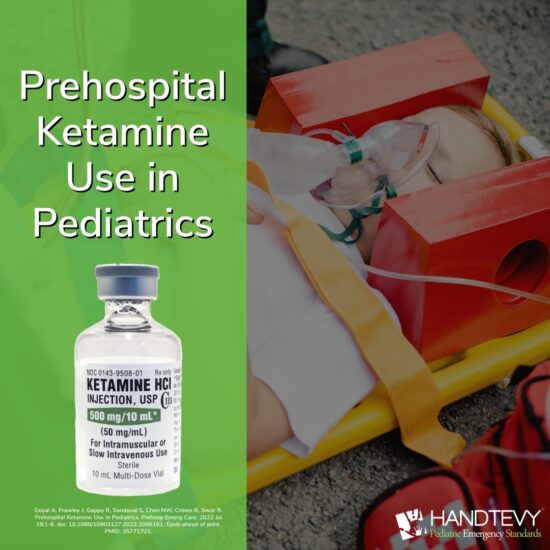Prehospital Ketamine Use in Pediatrics

The primary focus of the study was to understand the characteristics of pediatric patients who received ketamine during EMS transports and to assess the effectiveness, dosing deviations, and potential adverse outcomes.
Background:
Ketamine, developed in 1962, has been widely used for pediatric sedation in emergency departments before painful procedures. It is effective in treating chronic pain conditions like sickle cell disease. The drug offers both analgesic and amnestic properties while maintaining airway reflexes, spontaneous respiration, and cardiopulmonary stability. However, its use in the prehospital setting among children remains controversial due to potential adverse effects like laryngospasm, hallucinations, or vomiting.
Methodology:
The researchers conducted a retrospective data review of records from the ESO Data Collaborative for all 9-1-1 transports of pediatric patients (≤ 18 years of age) who received ketamine from 2019-2020. They used EMS primary impressions as a proxy for medication indication and defined effectiveness as paramedic-identified clinical improvement.
Key Findings:
- Demographics: Out of 422,968 ground-ambulance pediatric patients, 1,291 received ketamine. The majority were male (65.2%), teenagers with a median age of 16, Caucasian (62.7%), and from urban areas (80.6%).
- Indications: The most common EMS impressions were related to injuries (62.7%) and behavior disorders (21.8%).
- Effectiveness: Most patients (74.4%) received a single dose of ketamine, with EMS clinicians reporting improvement in 89.1% of these patients. Pain scores decreased significantly from a median of 8 to 2, with 59% of patients reporting pain score reductions of 2 or more points.
- Adverse Outcomes: Desaturation (<90% SpO2) events were minimal (1.8%). A small number (2.2%) received positive pressure ventilation without advanced airway placement. No prehospital deaths were documented.
- Dosing: Only 980 out of 1,291 (75.9%) had weights and identifiable routes recorded. About 14% of patients received 2-5 times the recommended dose, 2.1% received 5-10 times the recommended dose, and 1.2% received more than 10 times the recommended dose.
What are our takeaways?
Ketamine is a safe and effective drug when used appropriately. This study confirms that in pediatrics Ketamine is mainly used for pain control and is highly effective. Overdoses do occur when using the IV form. We’d advise agencies to consider non-IV routes (IM/IN/NEB) in kids to ensure safety and reduce errors.
Read the study here:
http://ow.ly/O9gT50KsltP

Peter Antevy, MD
Source: Goyal, A., Frawley, J., Gappy, R., Sandoval, S., Chen, N.-W., Crowe, R., & Swor, R. (2022). Prehospital Ketamine Use in Pediatrics. Prehospital Emergency Care.
DISCLAIMER:Pediatric Emergency Standards Inc. does not make clinical or medical decisions. The Handtevy System is intended to be utilized as a guide only. Provider’s experience and training should be the final determinant of clinical treatment decisions.

